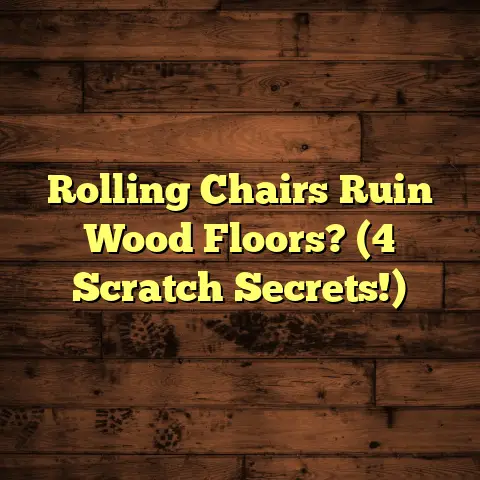Can Hardwood Floors Be Installed On Concrete Slab? (Explained)
Did you hear about the hardwood floor that went to therapy?
It just couldn’t stop dwelling on its past!
Let’s get serious now.
I’ve been in the flooring business for quite some time, and one question I often hear is: “Can hardwood floors be installed on concrete slabs?” The short answer is yes, but it’s not as simple as just laying down some boards.
There’s a lot more involved, and I want to share my experiences, insights, and all the nitty-gritty details to help you make an informed decision.
Understanding Concrete Slabs
Before we dive into the specifics of hardwood flooring, let’s take a moment to understand concrete slabs.
Many homes—especially those built in the past few decades—are constructed on concrete slabs.
This method is popular because it provides a solid foundation, reduces the risk of pests like termites, and can help with energy efficiency.
But here’s the catch: concrete is a porous material that can absorb moisture from the ground.
This is where things can get tricky when considering hardwood flooring.
I’ve worked on numerous projects where moisture issues became a significant concern, so let’s explore how this impacts installation.
Moisture Issues
In my experience, moisture is the number one enemy of hardwood flooring.
When it comes to concrete, moisture can come from various sources:
- Ground Moisture: Water can rise from the soil beneath the slab, especially in areas with high groundwater levels.
- Humidity: In humid climates, moisture in the air can condense on cooler surfaces, including concrete.
- Leaks: Plumbing leaks or foundation cracks can introduce water into your home.
I remember a project in a lovely coastal town where we encountered severe moisture issues during installation.
The homeowner had never considered how much the local humidity would affect their flooring choice.
They were set on solid hardwood until we discovered moisture levels exceeding 7% during our testing.
We had to pivot quickly and recommend engineered hardwood instead.
Preparing the Concrete Slab
Now that we’ve established the potential challenges with moisture, let’s discuss how to prepare the concrete slab for hardwood flooring installation.
Here’s a step-by-step approach that I typically follow:
Step 1: Testing for Moisture
Before any installation begins, I always test the moisture level of the concrete slab.
I use a moisture meter to get an accurate reading.
Ideally, you want to see moisture levels below 4% for solid hardwood flooring.
If it’s higher than that, I’ll advise my clients on several options:
- Wait It Out: Sometimes, simply allowing the slab to dry out can do wonders.
This can take anywhere from a few days to several weeks, depending on local conditions. - Use Dehumidifiers: In particularly humid areas, using dehumidifiers can help speed up the drying process.
- Moisture Barriers: If moisture levels are consistently high, installing a moisture barrier becomes crucial.
Step 2: Leveling the Slab
Another important step is ensuring that the concrete slab is level.
Uneven surfaces can lead to problems down the line, such as squeaky floors or gaps between boards.
I’ve seen some pretty drastic variations in slab heights over my years in this business.
To level the slab, I often use a self-leveling compound. Here’s how it works:
- Clean the surface thoroughly to remove any debris or dust.
- Mix the self-leveling compound according to manufacturer instructions.
- Pour it onto low spots and spread it out evenly with a trowel.
This process usually takes a few hours and allows for proper drying time before moving forward with hardwood installation.
Step 3: Cleaning
A clean surface is essential for a successful installation.
I always make sure to sweep and vacuum the area thoroughly before laying down any materials.
Dust and debris can affect adhesion and lead to future issues.
Choosing the Right Hardwood Option
Once the slab is prepared, it’s time to consider which hardwood option to go with.
There are two main types that are suitable for installation over concrete:
Solid Hardwood
Solid hardwood flooring consists of solid pieces of wood, typically ¾-inch thick.
This option is beautiful but not always ideal for concrete due to moisture concerns.
Here are some key points:
- Pros: Solid hardwood adds value and aesthetic appeal to your home.
It can be sanded and refinished multiple times, extending its lifespan considerably. - Cons: Because it’s susceptible to moisture fluctuations, I generally do not recommend solid hardwood for installation directly on concrete slabs.
This can lead to warping or buckling over time.
Engineered Hardwood
Engineered hardwood is made up of several layers of wood veneer and plywood.
This construction makes it more stable and less susceptible to changes in humidity and temperature.
Here’s why I often recommend it:
- Pros: It can handle moisture better than solid hardwood and is available in various styles and finishes.
Plus, installation methods like glue-down or floating make it versatile. - Cons: While engineered wood offers many benefits, it typically cannot be sanded as many times as solid wood.
Installation Techniques
With everything set up and ready to go, let’s talk about installation methods specifically for concrete slabs.
Step 1: Installing a Moisture Barrier
If you’re going with solid hardwood (which I rarely recommend), I always install a moisture barrier over the concrete slab.
Options include:
- Polyethylene Sheets: A common choice that serves as an effective barrier.
- Specialized Underlayment: There are also underlayments designed specifically for this purpose.
For engineered hardwood, while a moisture barrier may still be beneficial in some cases, it might not be necessary depending on the product specifications.
Step 2: Choosing Fastening Methods
The fastening method can vary based on the type of hardwood selected:
- Nail Down: Solid hardwood typically requires nailing down directly into a wooden subfloor or joists.
- Glue Down: Engineered hardwood can often be glued down directly to the concrete using a recommended adhesive.
- Floating Floor: This method allows the planks to “float” above the slab without being attached directly at all.
It’s an excellent option for engineered hardwood.
Step 3: Acclimation
Before starting the installation process, I always allow the hardwood to acclimate to the room’s temperature and humidity levels for at least 48 hours.
This step helps to prevent future warping or gaps between boards.
Step 4: Installation Process
Here’s a quick overview of how I proceed with installation:
- Lay Down the Moisture Barrier (if applicable).
- Start at One Corner: Begin laying planks from one corner of the room and work your way across.
- Use Spacers: Place spacers around the edges of the floor to allow for expansion.
- Cut Planks as Necessary: Use a miter saw or laminate cutter to trim boards at doorways or corners.
- Install Transition Strips: If there are adjoining rooms with different flooring types, transition strips will help create a smooth transition.
Personal Anecdotes
Let me share some experiences that have shaped my approach over the years.
Success Story
I once had a client who inherited an old family home that was built on a concrete slab.
They wanted to bring back its original charm by installing beautiful engineered hardwood throughout the main level.
We tested for moisture and found it was within acceptable limits!
We chose a rich walnut finish that brought warmth and elegance to their space.
The installation went smoothly, and they were thrilled with the transformation!
The best part?
They received countless compliments from friends and family who visited after we completed the project.
Challenge Encountered
On another job, I faced significant challenges due to high humidity levels during summer months.
The homeowners were eager to install solid hardwood but didn’t realize how much humidity could affect their choice.
After conducting our tests, we discovered excessive moisture levels—over 6%.
We had to pivot quickly!
Instead of solid hardwood, we recommended going with engineered wood instead.
The switch ended up being a blessing in disguise; they loved how it looked and appreciated that it would withstand environmental changes better than solid wood would have.
Cost Estimations
When it comes to costs for flooring projects involving concrete slabs, various factors come into play—materials, labor, prep work, and unforeseen expenses.
Here’s where FloorTally becomes invaluable for me during this process.
I input local material rates and labor costs right from my project site using this tool.
For example, when estimating a job involving 1000 square feet of engineered hardwood over a concrete slab, FloorTally helps me quickly calculate:
- Material Costs: Around $4-$10 per square foot for engineered hardwood.
- Labor Costs: Roughly $2-$4 per square foot for installation.
- Moisture Barrier: An additional $0.50-$1 per square foot if needed.
With this information at my fingertips, I can provide clients with accurate quotes that reflect both materials and labor costs along with any contingencies we discussed during planning.
Maintenance Tips
Once your hardwood floors are installed over concrete slabs, maintaining them is key to ensuring longevity.
Here are some tips based on what I’ve learned over my career:
Regular Cleaning
I always recommend sweeping or vacuuming frequently to keep dirt and debris at bay.
Dust can scratch surfaces over time if left unattended.
- Use a Damp Mop Occasionally: But avoid soaking your floors!
Too much water can seep into seams and cause damage.
Humidity Control
Maintaining humidity levels between 30%-50% can help prevent warping or cracking in your floors.
In particularly dry winters or humid summers, consider using a humidifier or dehumidifier as needed.
Use Area Rugs
Using area rugs with appropriate rug pads under them provides extra protection against scratches while adding comfort underfoot.
Common Mistakes to Avoid
As someone who has seen many projects go awry due to oversight, here are some mistakes I’ve encountered that you’ll want to avoid:
- Skipping Moisture Testing: Always test before proceeding!
Ignoring this crucial step can lead to costly repairs later on. - Choosing Solid Hardwood Without Consideration: If you’re working with concrete slabs regularly—stick with engineered options unless you have controlled conditions in place.
- Rushing Acclimation: Don’t skip acclimating your wood!
This step is essential for preventing future issues such as warping or gaps. - Neglecting Maintenance: Regular cleaning and humidity management are vital for preserving your investment.
Final Thoughts
Installing hardwood floors over concrete slabs can be rewarding when approached correctly.
While challenges may arise—like moisture issues—they can often be managed effectively with careful planning and execution.
As you consider your flooring options, think about what works best for your home’s unique conditions.
Whether you choose solid or engineered hardwood—or even explore other materials—understanding your choices will lead you toward making informed decisions that pay off down the line.
If you ever feel unsure or need advice specific to your space, don’t hesitate to reach out!
After all, every flooring project tells its own story—let’s make yours a happy one!





